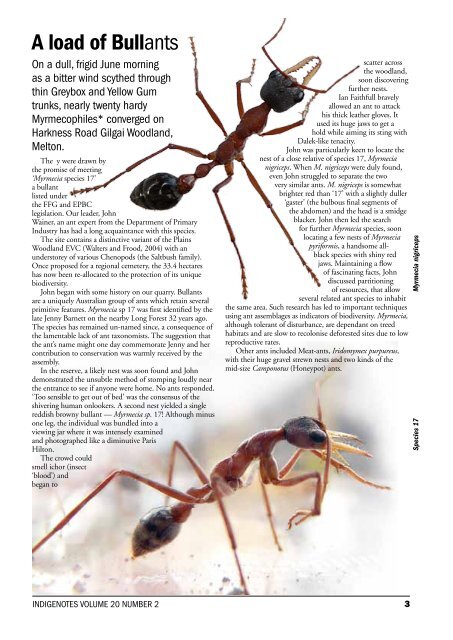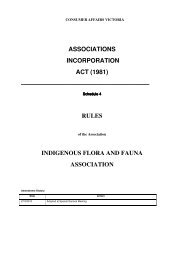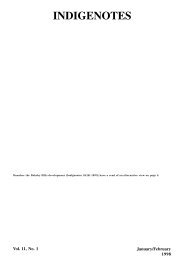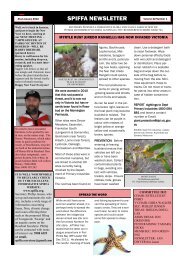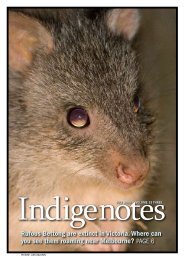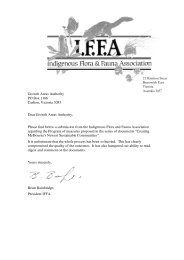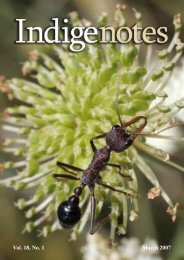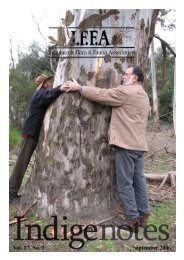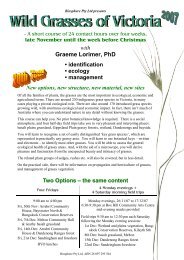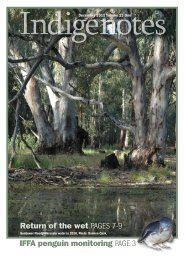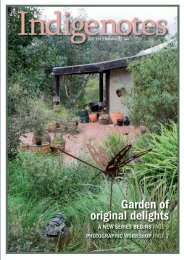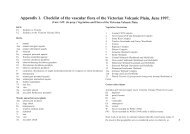July 2009 Volume 20 Two - Indigenous Flora and Fauna Association
July 2009 Volume 20 Two - Indigenous Flora and Fauna Association
July 2009 Volume 20 Two - Indigenous Flora and Fauna Association
You also want an ePaper? Increase the reach of your titles
YUMPU automatically turns print PDFs into web optimized ePapers that Google loves.
A load of Bullants<br />
On a dull, frigid June morning<br />
as a bitter wind scythed through<br />
thin Greybox <strong>and</strong> Yellow Gum<br />
trunks, nearly twenty hardy<br />
Myrmecophiles* converged on<br />
Harkness Road Gilgai Woodl<strong>and</strong>,<br />
Melton.<br />
The y were drawn by<br />
the promise of meeting<br />
‘Myrmecia species 17’<br />
a bullant<br />
listed under<br />
the FFG <strong>and</strong> EPBC<br />
legislation. Our leader, John<br />
Wainer, an ant expert from the Department of Primary<br />
Industry has had a long acquaintance with this species.<br />
The site contains a distinctive variant of the Plains<br />
Woodl<strong>and</strong> EVC (Walters <strong>and</strong> Frood, <strong>20</strong>04) with an<br />
understorey of various Chenopods (the Saltbush family).<br />
Once proposed for a regional cemetery, the 33.4 hectares<br />
has now been re-allocated to the protection of its unique<br />
biodiversity.<br />
John began with some history on our quarry. Bullants<br />
are a uniquely Australian group of ants which retain several<br />
primitive features. Myrmecia sp 17 was first identified by the<br />
late Jenny Barnett on the nearby Long Forest 32 years ago.<br />
The species has remained un-named since, a consequence of<br />
the lamentable lack of ant taxonomists. The suggestion that<br />
the ant’s name might one day commemorate Jenny <strong>and</strong> her<br />
contribution to conservation was warmly received by the<br />
assembly.<br />
In the reserve, a likely nest was soon found <strong>and</strong> John<br />
demonstrated the unsubtle method of stomping loudly near<br />
the entrance to see if anyone were home. No ants responded.<br />
‘Too sensible to get out of bed’ was the consensus of the<br />
shivering human onlookers. A second nest yielded a single<br />
reddish browny bullant — Myrmecia sp. 17! Although minus<br />
one leg, the individual was bundled into a<br />
viewing jar where it was intensely examined<br />
<strong>and</strong> photographed like a diminutive Paris<br />
Hilton.<br />
The crowd could<br />
smell ichor (insect<br />
‘blood’) <strong>and</strong><br />
began to<br />
scatter across<br />
the woodl<strong>and</strong>,<br />
soon discovering<br />
further nests.<br />
Ian Faithfull bravely<br />
allowed an ant to attack<br />
his thick leather gloves. It<br />
used its huge jaws to get a<br />
hold while aiming its sting with<br />
Dalek-like tenacity.<br />
John was particularly keen to locate the<br />
nest of a close relative of species 17, Myrmecia<br />
nigriceps. When M. nigriceps were duly found,<br />
even John struggled to separate the two<br />
very similar ants. M. nigriceps is somewhat<br />
brighter red than ‘17’ with a slightly duller<br />
‘gaster’ (the bulbous final segments of<br />
the abdomen) <strong>and</strong> the head is a smidge<br />
blacker. John then led the search<br />
for further Myrmecia species, soon<br />
locating a few nests of Myrmecia<br />
pyriformis, a h<strong>and</strong>some allblack<br />
species with shiny red<br />
jaws. Maintaining a flow<br />
of fascinating facts, John<br />
discussed partitioning<br />
of resources, that allow<br />
several related ant species to inhabit<br />
the same area. Such research has led to important techniques<br />
using ant assemblages as indicators of biodiversity. Myrmecia,<br />
although tolerant of disturbance, are dependant on treed<br />
habitats <strong>and</strong> are slow to recolonise deforested sites due to low<br />
reproductive rates.<br />
Other ants included Meat-ants, Iridomymex purpureus,<br />
with their huge gravel strewn nests <strong>and</strong> two kinds of the<br />
mid-size Camponotus (Honeypot) ants.<br />
Myrmecia nigriceps<br />
Species 17<br />
INDIGENOTES VOLUME <strong>20</strong> NUMBER 2 3


